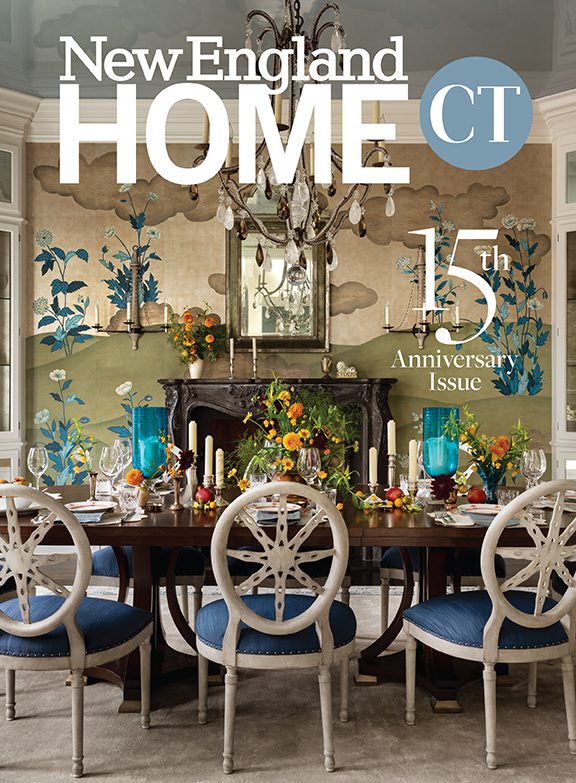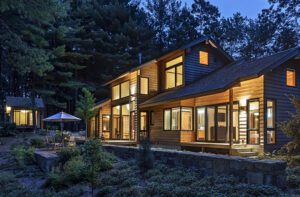True Originals: Connecticut Furniture Makers
July 28, 2017
Two Connecticut furniture makers—one responding to the beauty of nature, the other to the specific needs of designers—prove you don’t have to leave the state to find just the right piece.
Text by Debra Judge Silber Photography by Derek Dudek
A tree that falls in the forest may not make a sound—but let that same tree fall on a city street, and it’s likely to make a major statement. Particularly if it falls into the hands of Ted and Zeb Esselstyn.
The two brothers run City Bench, a company that collects felled trees from urban streetscapes and suburban yards, slices them into slabs, and shapes them into unique pieces of furniture. It’s a mission that employs hand-craftsmanship to capture the beauty of nature while reconnecting us with the forgotten practice of using every resource. “It’s what they did hundreds of years ago,” says Ted, an artist who hit on the idea when a commission for the Connecticut Resources Recovery Authority led him to consider the connection between people and the waste they produce. “We’re just reconnecting the circle.”
For Zeb, celebrating the life story engrained in these slabs is what City Bench is all about. “These urban trees have such a hard life, yet they survive,” he says. “They always have a story to tell.” Some come to City Bench scarred by nature or by man (some are embedded with metal, glass, and other urban debris); others with connections to our own past. Among the most stirring stories preserved by City Bench is that of the Lincoln Oak, planted on the New Haven Green in 1909 by Civil War Veterans marking the centennial birthday of the assassinated president. Uprooted by Superstorm Sandy in 2012, the tree’s heritage remains preserved in a public bench in City Hall.
The brothers obtain most of the wood for their projects from the city of New Haven, which removes more than 600 trees annually and provides land on which City Bench operates its sawmill. In turn, the brothers deliver woodchips, benches, and bridges for city parks and schools. The rest of the wood comes from local tree wardens and homeowners reluctant to part with favorite trees whose age or location require removal.
With the assistance of woodworkers Ben Komola and Graeme Stasyshyn, the brothers produce 80 to 100 pieces a year at a rustic compound they built in their Higganum backyard. In one of those buildings, raw slabs lean upright against a wall, chalk marks detailing their origins: red oak from Elizabeth Park in Hartford, elm from Grove Street in New Haven, cherry from a yard in Westport. Faint grain lines hint at the graceful and sometimes tempestuous patterns that will emerge as the wood is shaped and smoothed. The slabs are dried in a kiln the brothers built themselves and leveled on a homemade jig before they’re assembled in the adjacent workshop into dining tables and countertops, bench seats and desks.
The majority of City Bench’s work is by commission, but some finished pieces are available at their showroom/warehouse (open by appointment). Most designs are simple, yielding to the experience of the tree, although some incorporate steel, Lucite, or a splash of color into the legs. “We try to keep our hands
off the slab,” says Komola, “and let the wood speak for the piece.”
At Old Mill Road Table Company in Bridgeport, Tom Dwyer furnishes his designer-clients with his own brand of wish fulfillment. He designs and builds hyper-customized versions of popular furniture styles, meeting his clients’ exact specifications to an extent that traditional manufacturers can’t match. “When a designer comes to me, they don’t say, ‘Design me a table,’ ” Dwyer says. “They say, ‘This is what will fit my client.’ So I make whatever they want.”
With the help of three carpenters, Dwyer produces roughly a dozen tables a month. In less than four years he’s gained a following among the region’s top designers, and his creations grace entries, dining rooms, and offices from Connecticut to New Zealand.
Although he built his family’s first dining room table more than thirty years ago, Dwyer doesn’t see himself as a woodworker. His talent for table-making lies instead in the communication and visualization skills he developed running an advertising graphics firm during the waning days of New York’s Mad Men era. He’s not the magician, but he’s the guy who makes the magic happen. “I do, now, exactly what I did in advertising,” he says. “I’m in the client’s corner. I know what they want, and I know how to get it.”
Designers bring Dwyer sketches or photos of the piece they envision (he keeps a magnifying glass on hand to spot the details), along with their client’s unique specifications. The resulting design might swap walnut for oak, metal for Lucite, or stone for glass. It might be taller or narrower or wider than the piece that inspired it—whatever it takes to recreate the image in the designer’s head. While that can lead to more than a few challenges, Dwyer embraces their cause. “They tell me what they want to do. Then it’s my problem to make it work.”
City Bench
73 Maple Ave., Higganum
(860) 716-8111
city-bench.com
Old Mill Road Table Company
67 Poland St., Bridgeport
(917) 690-9814
oldmillroadtable.com
Share
![NEH-Logo_Black[1] NEH-Logo_Black[1]](https://b2915716.smushcdn.com/2915716/wp-content/uploads/2022/08/NEH-Logo_Black1-300x162.jpg?lossy=1&strip=1&webp=1)

















You must be logged in to post a comment.